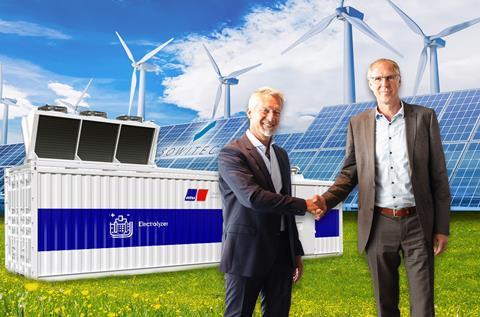Engine manufacturers are expanding their renewable energy programs, most recently with Rolls-Royce Power Systems and SOWITEC, a specialist in renewable energy projects, agreeing to cooperate on power-to-X projects with a total electrolysis capacity of up to 500 megawatts by 2028.
The plants will use renewable energy sources to generate electrical power that will be used to produce hydrogen with mtu electrolysers. This green hydrogen can be used as fuel for fuel cells and hydrogen engines, to produce industrial feedstock and to produce sustainable e-fuels for marine, aviation, agriculture, mining and data centre power.
Rolls-Royce brings a wide range of its own new products to the cooperation for the production and use of sustainable fuels based on green hydrogen: these include mtu electrolysers, mtu fuel cell systems and mtu hydrogen engines, as well as experience with hydrogen ecosystems and in the simulation, design and optimization of decentralized energy supply systems.
Rolls-Royce is already successfully operating an mtu fuel cell system, developing electrolysers to produce green hydrogen, and gradually releasing its main engines for sustainable fuels such as hydrotreated vegetable oils (HVO). The mtu gas engine portfolio is currently being prepared for hydrogen as a fuel, thus enabling a CO2-neutral energy supply.
German project for MAN
News of the agreement comes shortly after MAN Energy Solutions and the Fraunhofer Institute for Surface Engineering and Thin Films (IST) published their analysis of the framework conditions for the future supply of green hydrogen to the Salzgitter steel site near Hannover, Germany. Commissioned by Hydrogen Campus Salzgitter, the study’s calculations show that – if used directly without further conversion – local hydrogen can be economical and even cheaper than imports from 2030 onwards. While production costs of around 4.00 euros per kilogram are possible in northern Germany, hydrogen imported from Tunisia, for example, would cost at least 4.70 euros to produce.
For the study, the authors modelled different supply chains for green hydrogen and compared possible import routes, such as those from Portugal, Canada, Tunisia and Australia. Although green hydrogen can be produced much more cheaply in countries with significant amounts of sunshine, it must then be converted for transport to Germany and subsequently back again for domestic use. This process step, which is fraught with costs and losses, drives the total expense above the cost price of hydrogen produced from wind energy in northern Germany, which can be transported by pipeline to its destination for immediate use.
MAN Energy Solutions is also preparing its engines for sustainable fuels including hydrogen. Most recently, it is offering a lifecycle upgrade to retrofit older MAN 48/60 marine and power-plant engines. Converted engines will effectively be equivalent technically to newly built MAN 51/60 units and, as a result, achieve significant savings in fuel consumption, CO2 and pollutant emissions, and increase reliability. As a further option, newly converted engines can be upgraded for operation on synthetic fuels for a low premium.
Wärtsilä eyes Asian opportunities
“Rolls-Royce Power Systems announced a deal to cooperate with SOWITEC, a German renewables specialist, on power-to-X projects.” “/ / 
Source: Rolls-Royce Power Systems
Rolls-Royce Power Systems announced a deal to cooperate with SOWITEC, a German renewables specialist, on power-to-X projects.
Further afield, power system modelling by Wärtsilä has revealed that renewable-based power systems, backed by grid balancing engines and energy storage, can enable Southeast Asian countries to reach net zero by mid-century whilst cutting the levelised cost of electricity (LCOE) by over 20%, when taking into account likely future carbon taxes.
The modelling, published in Rethinking Energy in Southeast Asia report, simulates the paths to net zero emissions in three major Southeast Asian power systems: Vietnam; the island of Sulawesi in Indonesia; and the island of Luzon in the Philippines.
The study shows that a combination of renewables plus flexibility, provided by balancing engines and energy storage, can reliably meet the increasing power demand. In all the countries modelled, the ‘Net Zero’ scenario shows that inflexible fossil fuel assets, such as coal or combined cycle gas turbines (CCGTs), should be phased out. New investments should focus on adding renewable energy sources, increasing flexible capacity, and developing sustainable fuels such as green hydrogen.
Wärtsilä Energy’s technologies cover future-fuel enabled balancing power plants, hybrid solutions, energy storage and optimisation technology, including its GEMS energy management platform.




